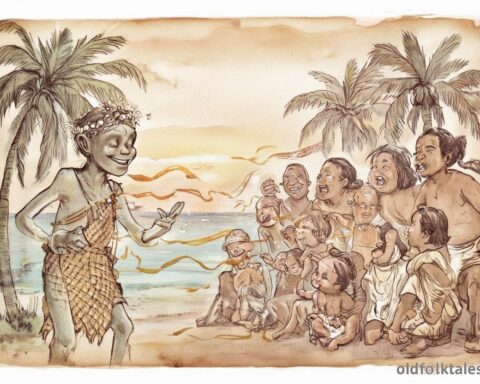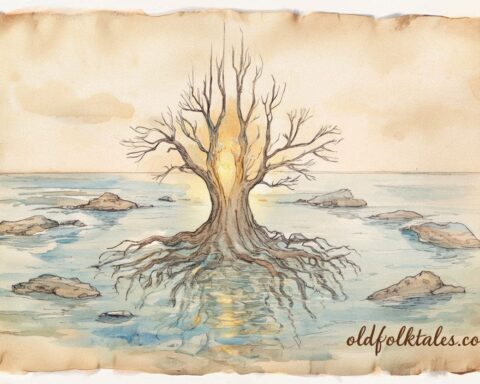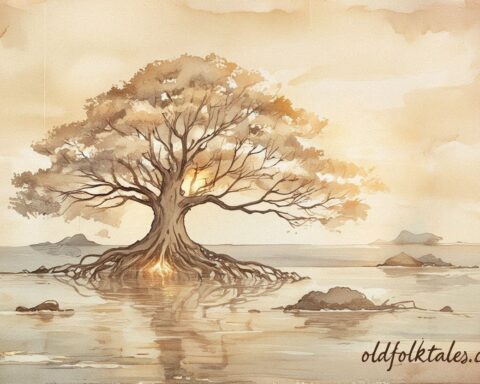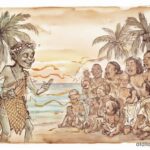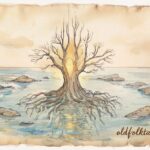In the beginning there was sky and quiet and the slow breath of possibility. The world lay flat and empty. The sea kept its own counsel and the land slept under a pale sheet of stillness. From that wide silence came Baiame, the Sky Father, a spirit who carried both the vastness of the heavens and the care of a gentle parent.
Baiame looked upon the sleeping earth and felt a longing to give it story and form. He walked along the plain and, where his feet pressed, furrows opened that would become rivers. His hands swept across the soil and hills rose like remembering bodies. He shaped mountains and carved valleys. He blew a warm wind and the wind became the first song. This song taught the land how to keep its own music.
Life came when Baiame breathed. He exhaled and gum trees stood up across the red earth. He clapped his hands and emus and kangaroos stirred from the dust. His laughter scattered birds into the dawn. Yet the land still needed those who would tell its tales. It needed singers who would carry memory in their voices, who would mark the places Baiame had touched and keep the law he had given.
Sail through the legends of brave navigators, ocean spirits, and island gods
So Baiame made people from clay taken from riverbanks and from the shell dust at the water edges. He shaped faces and hands. He leaned close and spoke into them words that were alive. These words were not merely speech. They were law, they were names, they were songs that stitched the people to the land and to one another.
“Remember the river is your relative,” Baiame taught. “Take only what the land offers freely. Share with those who hunger. Sing when you plant and when you harvest. Keep the fire sacred. Keep the stories true.”
The people learned to move with the seasons. They read the sky as one reads a map. They danced the paths of their ancestors. The songs they sang named rock shelter, waterhole, and stone. Those songs were stories of how the land was made, and those stories were a kind of map that tied each clan to its country.
Baiame remained with them for a time. He counselled elders and taught them the ceremonies that would keep balance. He taught the people how to carve and how to paint, how to make fire and how to ask permission of the spirits before taking. He taught that the sea and the land were not separate but threads of the same cloth. His lessons were gentle and firm, and they had the sort of quiet authority that comes from deep care.
When his work was done Baiame did not vanish. He rose slowly into the sky and made his home among the stars. From above he kept his watch. When storms came and when the tide spoke its loud language he was still there, listening and remembering. The people saw his light in the dawn and in the silver of the moon. They felt his breath in the onshore wind.
In time other voices came to the coasts from distant islands. Trickster tales that rode on canoes and on salt wind blended with the Dreamtime songs. From Micronesia came stories of clever sea spirits who changed shape and taught lessons by mischief. The people listened. They found that Baiame’s law and the trickster’s mischief both taught how to live. The trickster reminded them that wisdom could arrive by surprise and that pride could unravel a life as surely as drought could dry a river.
So the people learned to balance reverence with laughter. They kept Baiame’s sacred rules and they also kept the trickster’s clever tests. A young hunter might sing Baiame’s song before he set out and later laugh at the tale of a playful sea spirit who stole a canoe paddle to teach a lesson about greed. In this way the land and ocean spoke to each other. The Dreamtime was not only a history. It was a living law and a living joke and it taught both restraint and joy.
Through generations the songs endured. Elders taught initiation songs that spoke of Baiame and of the sea spirits who reminded people to be humble. Children learned that to live well one must be patient with the land and cunning enough to read the sea. The story of Baiame became the backbone of a people who walked lightly upon their world and who listened carefully to the tide.
The story asks of us one simple thing. Treat the world with care, honor the laws that hold communities together, and keep open the heart to laughter and to change. In the rhythm of those three acts the world stays whole.
Moral Lesson
The story of Baiame teaches that creation is sacred, law is love made practical, and wisdom comes both from solemn teaching and from playful humility.
Knowledge Check
1. Who is Baiame in this story?
Baiame is the Sky Father, the creator spirit who shapes the land and gives law to the first people.
2. How did Baiame create living things?
He breathed life into the world, molded people from clay, and caused plants and animals to arise where he touched the ground.
3. What core teachings did Baiame give to the people?
He taught respect for the land, sharing of resources, and the sacred songs that connect people to place.
4. How is Micronesian storytelling woven into this version?
Through ocean trickster tales that teach humility and balance alongside Baiame’s laws.
5. What moral balance does the story emphasize?
The harmony between reverence for sacred order and the wisdom of laughter and humility.
6. How do songs function in the Dreamtime tradition shown here?
They serve as law, story, and map, preserving the memory of creation and the link between people and land.
Source
Adapted from “Baiame” in Aboriginal Myths: Tales of the Dreamtime by A. W. Reed (1978), Terrey Hills, N.S.W.: Reed.
Cultural Origin
Australian Aboriginal (Dreamtime traditions of south-eastern Australia)

